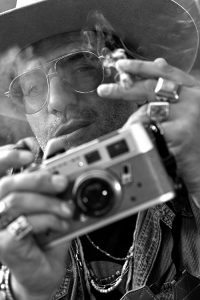
©Mathieu Bitton
Mathieu Bitton
PREY POWER
ELEUTHERA, BAHAMAS, 2016
Silver Gelatin Fiber Print. Leica Monochrom
40 x 60
$7,500

©Per Bernal
For Grammy-winning artist and Leica Camera ambassador Mathieu Bitton, what you hear and what you see are one in the same. Colors and music notes have similar shades; lyrics and hand-drawn lines have similar emotional messages. Each genre of music in Bitton’s collection has its own visual world in his head – jazz takes on certain hues, while rock n’ roll is another vibrant texture completely. For Bitton, one simply does not exist without the other. And this special way of merging both mediums is what has lead Mathieu Bitton to be one of the music world’s most sought-after designers, creating album covers and packaging, as well as videos, photographs, logos and more for some of the most iconic artists and records of the last century, in addition to earning him a Grammy nomination for his artistic achievement. His vast and vast body of work has seen him designing album art and poster art for a who’s who of musical history, including Lenny Kravitz, Prince, Jack White, Sting, Miles Davis (he designed the incredible packaging to the Bitches’ Brew 40th Anniversary Edition box set), Dave Chappelle, Marvin Gaye, Jane’s Addiction, Bob Marley, Quincy Jones, James Brown, George Clinton, Earth, Wind & Fire, Iggy Pop, Lou Reed, Dolly Parton and many more. If there’s an album cover that moves you, inspires you or impacts you, the odds are pretty high that Mathieu Bitton created it.
Q&A:
My very first Leica was given to me by my godfather, Gerard Darel, when I was a teenager in Paris. It was a silver Leicaflex SL. Then during a trip to Vienna, I got my first mint condition, 1955 M3. That’s when I completely fell in love with the M system. As far as digital cameras, while touring with Lenny Kravitz in 2009, he was kind enough to let me play with his M8 once in a while. I then got an M9 for myself. I have gotten every M camera ever since and started the dangerous practice of collecting vintage Leica cameras, including black, paint ones.
My M2 black paint from 1961 with rigid 50 mm lens, a camera that belonged to Magnum photographer, Paul Fusco, is definitely my favorite. As far as digital Leicas, the M11 monochrom never leaves my side.
What is your favorite subject matter to shoot?
I love photographing artists, be it musicians or comedians. Actors are interesting too, but are much more self-conscious, and often try to control the photographs. That’s something I still have to push through in my own work. Mainly I just love street photography, which was the subject of my first exhibition with Leica, Darker Than Blue, and will be partially the next one titled Paris Blues.
What other Leica camera are you thinking of getting?
l often think of shooting with the S system.
How has Leica changed your life?
Leica has changed my life in the way that it has given me a lot of confidence primarily because the images always look so incredible and the cameras – which all look like works of art – are a great conversation piece. Just today in Washington DC, as I write this, three different people have stopped me to discuss the two Leicas on my shoulders. If you look throughout history, people like Robert Capa or Henri Cartier-Bresson, and so many other legends, chose only the best, Leica. When shooting with Leica you feel like you are part of historic elite group of passionate people.
